TOOLS
Page 37
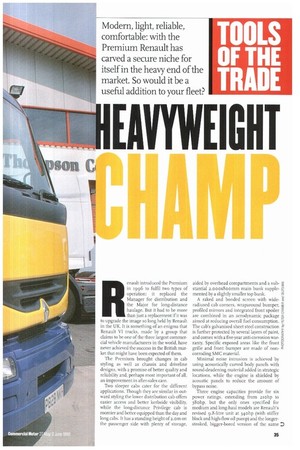
Page 39
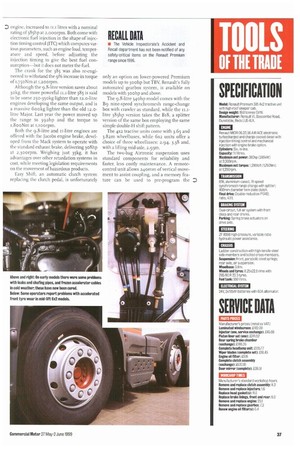
Page 41
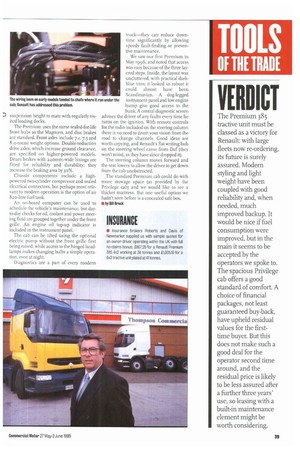
Page 38
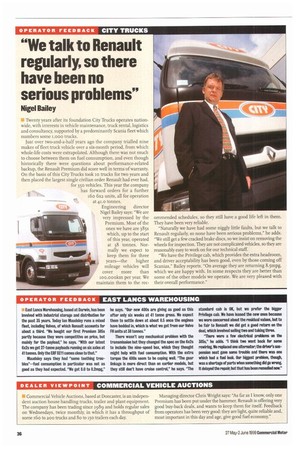
Page 40
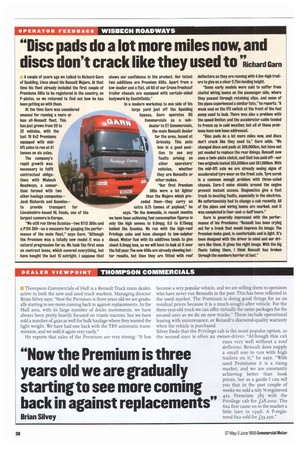
If you've noticed an error in this article please click here to report it so we can fix it.
OF THE
TRADE
Modern, light, reliable, comfortable: with the Premium Renault has carved a secure niche for itself in the heavy end of the market. So would it be a useful addition to your fleet?
Renault introduced the Premium in 1996 to fulfil two types of operation: it replaced the Manager for distribution and the Major for long-distance haulage. But it had to be more than just a replacement if it was to upgrade the image so long held by Renault in the UK. It is something of an enigma that Renault VI trucks, made by a group that claims to be one of the three largest commercial vehicle manufacturers in the world, have never achieved the success in the British mar• ket that might have been expected of them.
The Premium brought changes in cab styling as well as chassis and driveline designs, with a promise of better quality and reliability and, perhaps most important of all, an improvement in after-sales care.
Two sleeper cabs cater for the different applications. Though they are similar in outward styling the lower distribution cab offers easier access and better kerbside visibility, while the long-distance Privilege cab is roomier and better equipped than the day and long cabs. It has a standing height of 2.0M on the passenger side with plenty of storage,
aided by overhead compartments and a sub.1 stantial 2,000x800mm main bunk supple.,Fd mented by a slightly smaller top bunk.
A raked and bonded screen with wide2 radiused cab corners, wraparound bumper, ; profiled mirrors and integrated front spoiler are combined combined in an aerodynamic package ffi aimed at reducing overall fuel consumption. The cab's galvanised sheet steel construction -! is further protected by several layers of pain t, and comes with a five.year anti-corrosion warranty. Specific exposed areas like the front go grille and front bumper are made of noncorroding SMC material.
Minimal noise intrusion is achieved by using acoustically curved body panels with sound-deadening material added in strategic locations, while the engine is shielded by acoustic panels to reduce the amount of bypass noise.
Three engine capacities provide for six power ratings, extending from alohp to 38ohp, but the only ones specified for medium and long-haul models are Renault's revised 9.8-litre unit at 34ohp (with stiffer block and high-flow oil pump) and the longerstroked, bigger-bored version of the same D D engine, increased to TT.T litres with a nominal rating of 385hp at 2,000rpm. Both come with electronic fuel injection in the shape of injection timing control {ITC} which computes various parameters, such as engine load, temperature and speed, before adjusting the injection timing to give the best fuel consumption—bul it does not meter the fuel.
The crank for the 385 was also re-engineered to withstand the 9% increase in torque of ,75oNm at 1,2oorpm.
Although the 9.8-litre version saves about 30kg, the more powerful ir.r-litre 385 is said to be some 250-350kg lighter than r2.o-litre engines developing the same output, and is a massive 600kg lighter than the old 1.2..olitre Major. Last year the power moved up the range to 392hp and the torque to 1,800Nm at Ltoorpm.
Both the 9.8-litre and rr-litre engines are offered with the Jacobs engine brake, developed from the Mack system to operate with the standard exhaust brake, delivering 3o8hp at 2,300rpm. Weighing just 35kg, it has advantages over other retardation systems in cost, while meeting legislation requirements on the movement of hazardous products.
Easy Shift, an automatic clutch system replacing the clutch pedal, is unfortunately
RECALL DATA
a The Vehicle Inspectorate's Accident and Recall department has not been notified of any safety-critical items on the Renault Premium range since 1996.
only an option on lower-powered Premium models up to 300hp but TBV, Renault's fully automated gearbox system, is available on models with 3oohp and above.
The 9.8-litre 34ohp model comes with the B9 nine-speed synchromesh range-change box with crawler as standard, while the Hsilitre 385hp version takes the B18, a splitter version of the same box employing the same simple double-H shift pattern.
The 43/2 tractive units come with 3.65 and 3.82m wheelbases, while 6x2 units offer a choice of three wheelbases: 2.94, 3.38 and, with a lifting mid-axle, 2.93111.
The two-bag Airtronic suspension uses standard components for reliability and faster, less costly maintenance. A remotecontrol unit allows 24om rn of vertical movement to assist coupling, and a memory feature can be used to pre-program the D D suspension height to mate with regularly visited loading docks.
The Premium uses the same sealed-for-life front hubs as the Magnum, and disc brakes are standard. Front axles include 7.1, 7.5 and &o-tonne weight options. Double-reduction drive axles, which increase ground clearance, are specified on higher-powered models. Drum brakes with 220mm-wide linings are fitted for reliability and durability; they increase the braking area by 30%.
Chassis components include a highpowered two-cylinder compressor and sealed electrical connectors, but perhaps most relevant to modern operation is the option of an 820-litre fuel tank.
An on-board computer can be used to schedule the vehicle's maintenance, but dayto-day checks for oil, coolant and power steering fluid are grouped together under the front grille. An engine oil top-up indicator is included in the instrument panel.
The cab can be tilted using the optional electric pump without the front grille first being raised, while access to the hinged headlamps makes changing bulbs a simple operation, even at night
Diagnostics are a part of every modern
truck—they can reduce downtime significantly by allowing speedy fault-finding or preventive maintenance.
We saw our first Premium in May 1996, and noted that access was easy because of the three lay ered steps. Inside, the layout was uncluttered, with practical dark blue trim; it looked so robust it could almost have been Scandinavian. A dog-legged instrument panel and low engine hump give good access to the bunk. A central diagnostic screen advises the driver of any faults every time he turns on the ignition. With remote controls for the radio included on the steering column there is no need to divert your vision from the road to change channels. Good ideas are worth copying, and Renault's flat writing hub on the steering wheel came from Daf (they won't mind, as they have since dropped it).
The steering column moves forward and the seat lowers to allow the driver to get down from the cab unobstructed.
The standard Premium cab could do with more stowage space (as provided by the Privilege cab) and we would like to see a thicker mattress. But one useful option we hadn't seen before is a concealed safe box.
• by Bill Brock
INSURANCE
• Insurance brokers Roberts and Davis of Newmarket supplied us with sample quotes for an owner-driver operating within the UK with full no-claims bonus: £867.25 for a Renault Premium 385 4x2 working at 38 tonnes and 21,005.10 for a 6x2 tractive unit plated at 41 tonnes.
TOOLS
OF THE TRADE SPECIFICATION
Model: Renault Premium 385 4x2 tractive unit with high-roof sleeper cab.
Design weight 19.0 tonnes GVW Manufacturer: Renault VI, Boscombe Road, Dunstable, Beds LU5 4LX.
ENGINE
Renault MIDR 06.23.56 441 ACE electronic turbocharged and charge-cooled diesel with injection timing control and mechanical injection with engine brake option.
Cylinders: Six, in-line.
Capacity: 11.1 litres.
Maximum net power: 380hp {280kiN) at 2,000rom.
Maximum net torque: 1,290Ibft (1,750Nm) at 1,200rpm.
TRANSMISSION
818, aluminium-cased, 18-speed synchromesh range change with splitter; 400mm diameter twin-plate clutch. Final drive: Double-reduction P1342; -an°, 411.
BRAKING SYSTEM
Dual-circuit, full-air system with front discs and rear drums.
Parking Spring brake actuators on drive axle.
STEERING
ZF 8098 High-pressure, variable ratio hydraulic power assistance.
CHASSIS
Ladder construction with high-tensile-steel side-members and bolted cross-members. Suspension: Front, parabolic steel springs; rear axle, air suspension.
Wheelbase: 3.8m.
Wheels and tyres: 8.25x22.5 rims with 295/80 R 22.5 tyres.
Fuel tank: 550 litres.
ELECTRICAL SYSTEM
24V, 2x1654h batteries with 604 alternator.
SERVICE DATA
PARTS PRICES
Manufacturer's prices (retail ex VAT) Laminated windscreen: £182.00 Injector (one, service exchange): 145.68 Piston liner set tone): 011.52 Rear spring brake chamber (exchange): £180.35 Complete headlamp unit: £13537 Wiper blades (complete set):118.45 Engine oil filter: £9.15
Complete clutch assembly (exchange): ..634.10
Door mirror (complete): £39,51
WORKSHOP TIMES
manufacturer's standard workshop hours Remove and replace clutch assembly: 8.2 Remove and replace injectors:1,6 Replace head gasket(s): 11.9 Replace brake finings, front and roar: 6.0 Remove and replace engine: 25.1 Remove and replace gearbox: 7.2
Renew engine oil filter(s): 0.4
"We talk to Renault regularly, so there have been no serious problems"
Nigel Bailey
• Twenty years after its foundation City Trucks operates nationwide, with interests in vehicle maintenance, truck rental, logistics and consultancy, supported by a predominantly Scania fleet which numbers some i,000 trucks.
Just over two-and-a-half years ago the company trialled nine makes of fleet truck vehicle over a six-month period, from which whole-life costs were extrapolated. Although there was not much to choose between them on fuel consumption, and even though historically there were questions about performance-related backup, the Renault Premium did score well in terms of warranty. On the basis of this City Trucks took so trucks for two years and then placed the largest single civilian order Renault had ever had, for 350 vehicles. This year the company has forward orders for a further 160 6x2 units, all for operation at 41.0 tonnes.
Engineering director Nigel Bailey says: "We are very impressed by the Premium. Most of the ones we have are 3855 which, up to the start of this year, operated at 38 tonnes. Normally we expect to keep them for three years—the higher mileage vehicles will cover more than too,000km per year. We maintain them to the rec
ommended schedules, so they still have a good life left in them. They have been very reliable.
"Naturally we have had some niggly little faults, but we talk to Renault regularly, so none have been serious problems," he adds. "We still get a few cracked brake discs, so we insist on removing the wheels for inspection. They are not complicated vehicles, so they are reasonably easy to work on for our technical staff.
"We have the Privilege cab, which provides the extra headroom, and driver acceptability has been good, even by those coming off Scanias," Bailey reports. "On average they are returning 8.5mpg, which we are happy with. In some respects they are better than some of the other models we operate. We are very pleased with their overall performance."
OPERATOR FEEDBACK
EAST LANCS WAREHOUSING
East Lancs Warehousing, based at Darwin, has been involved with industrial storage and distribution for the past 35 years. Today Ian Maudsley runs a mixed fleet, including Volvos, of which Renault accounts for about a third. "We bought our first Premium 385s partly because they were competitive on price, but mainly for the payload," he says. "With our latest 6x2s we get 27-tonne payloads running on six axles at 41 tonnes. Only the ERF EC11 comes close to that."
Maudsley says they had "some teething troubles"—fuel consumption in particular was not as good as they had expected. "We got 8.0 to 8.2mpg,"
he says. "Our new 400s are giving as good as this after only six weeks at 41 tonne gross. We expect them to settle down at about 8.5 once the engines have bedded in, which is what we get from our Volvo FH units at 38 tonnes."
There wasn't any mechanical problem with the transmission but they changed the spec on the 6x2s to include the nine-speed box, which they thought might help with fuel consumption. With the extra torque the 400s seem to be coping well, "The gear linkage is more direct than on earlier models, but they still don't have cruise control," he says. "The standard cab is OK, but we prefer the bigger Privilege cab. We have leased the new ones because we were concerned about the residual values, but to be fair to Renault we did get a good return on the deal, which involved selling two and taking three.
'There were a few electrical problems on the 385s," he adds. "I think two went back for some rewiring. We replaced one alternator; the driver's suspension seat gave some trouble and there was one which had a fuel leak. Our biggest problem, though, was a shortage of parts when something did go wrong. It delayed the repair, but that has been remedied now."
DEALER VIEWPOINT COMMERCIAL VEHICLE AUCTIONS II Commercial Vehicle Auctions, based at Doncaster, is an independent auction house handling trucks, trailer and plant equipment. The company has been trading since 1989 and holds regular sales on Wednesdays, twice monthly, in which it has a throughput of some 16o to 200 trucks and 8o to 150 trailers each day. Managing director Chris Wright says: "As far as I know, only one Premium has been put under the hammer. Renault is offering very good buy-back deals, and wants to keep them for itself. Feedback from operators has been very good: they are light, quite reliable and, most important in this day and age, give good fuel economy."
OPERATOR FEEDBACK
WISBECH ROADWAYS
"Disc pads do a lot more miles now, and discs don't crack like they used to
%chard Garn
A couple of years ago we talked to Richard Darn of Spalding, Lines about his Renault Majors. At that time his fleet already included the first couple of Premiums 385s to be registered in the country, on P-plates, so we returned to find out how he has been getting on with them.
At the time Darn was considered unusual for running a more or less all-Renault fleet. This has just grown from 20 to 32 vehicles, with the last 19 6x2 Premiums equipped with mid lift axles to run at 41 tonnes on six axles. The company's rapid growth was
necessary to fulfil contractual obligations with Wisbech Roadways, a consortium termed with two other haulage companies— Jack Richards and Knowles—
to provide transport for Lincolnshire-based HI Foods. one of the largest canners in Europe.
"We still run three Scan ias—two R113 360s and a P124 360—as a measure for gauging the performance of the main fleet," says Darn. "Although the Premium was a totally new model it was a natural progression for us. We took the first ones on contract lease, which covered everything, but have bought the last 15 outright, I suppose that shows our confidence in the product. Our latest two additions are Premium 400s. Apart from a low-loader and a flat, all 60 of our Crane Fruehauf trailer chassis are equipped with curtain-sided bodywork by Southfields."
In a modern workshop to one side of his large yard just off the Spalding bypass, Darn operates RG Commercials as a subdealer to ET Commercials, the main Renault dealer for the area, based at Grimsby. This puts him in a good position to see any faults arising on other operators' vehicles, whether they are Renaults or other makes.
"Our first Premium 385s were a lot lighter than the Majors which preceded them—they carry an extra 0.75 tonnes of payload," he says. "On the downside, in recent months we have been achieving fuel consumption figures in only the high sevens to 8.0mpg: 0.5 to 0.75mpg behind the Scanias. We run with the high-roof Privilege cabs and have changed to low-sulphur diesel. Winter fuel with its additives tends to give about 0.5mpg less, so we will have to look at it over the full year. The new 400s are already showing better results, but then they are fitted with roof deflectors as they are running with 4.8m-high trailers to give us a clear 2.75m loading height.
"Some early models were said to suffer from chafed wiring looms on the passenger side, where they passed through retaining clips, and some of the pipes experienced a similar fate," he reports, "A weak seal an the ITC switch at the front of the fuel pump used to leak. There was also a problem with the speed limiter, and the accelerator cable tended to freeze up in cold weather, but all of these problems have now been addressed.
"Disc pads do a lot more miles now, and discs don't crack like they used to," Darn adds. "We changed discs and pads at 308.000km, but have not yet needed to replace the rear linings. Renault now uses a twin-plate clutch, and that has paid off—our two originals lasted 355,000km and 381,000km. With the mid-lift axle we are already seeing signs of accelerated tyre wear on the front axle. Tyre scrub is a common enough problem with three-axled chassis. Euro-2 noise shields around the engine prevent instant access. Diagnostics give a fast track to locating faults, especially in the eiectrics, We unfortunately had to change a cab recently. All of the pipes and wiring looms are marked, and it was completed in four-and-a-half hours."
Darn is generally impressed with the performance of his Premiums: "Renault has been crying out for a truck that would improve its image. The Premium looks good, is comfortable and is light. It's been designed with the driver in mind and our drivers like them. It gives the right image. With the big fleets taking them, I think Renault has broken through the numbers barrier at last.''
DEALER VIEWPOINT
THOMPSON COMMERCIALS
Thompson Commercials of Hull is a Renault Truck main dealer, active in both the new and used truck markets. Managing director Brian Silvey says: "Now the Premium is three years old we are gradually starting to see more coming back in against replacements. In the Hull area, with its large number of docks movements, we have always been pretty heavily focused on triaxle tractors, but we have sold a number of 4x2s as well for bulk haulage where they wanted the light weight. We have had one back with the TBV automatic transmission, and we sold it again very easily."
He reports that sales of the Premium are very strong: "It has become a very popular vehicle, and we are selling them to operators who have never run Renaults in the past. This has been reflected in the used market. The Premium is doing good things for us on residual prices because it is a much-sought-after vehicle. For the three-year-old truck we can offer virtually the same packages for the second user as we do on new trucks." These include operational leasing with maintenance, or Renault's diamond-quality warranty when the vehicle is purchased.
Silvey finds that the Privilege cab is the most popular option, as the second user is often an owner-driver. "Although this cab runs very well without a roof deflector, Renault does supply a small one to run with high trailers on it," he says. "With used Premiums it is a rising market, and we are constantly achieving better than book prices, but as a guide I can tell you that in the past couple of weeks we sold a tidy N.registered 43(2 Premium 385 with the Privilege cab for L28,000. The 6x2 first came on to the market a little later in 1996. A P-registered 6x2 sold for f33,250."
TOOLS
OF THE TRADE
VERDICT
The Premium 385 tractive unit must be classed as a victory for Renault: with large fleets now re-ordering, its future is surely assured. Modern styling and light weight have been coupled with good reliability and, when needed, much improved backup. It would be nice if fuel consumption were improved, but in the main it seems to be accepted by the operators we spoke to. The spacious Privilege cab offers a good standard of comfort. A choice of financial packages, not least guaranteed buy-back, have upheld residual values for the firsttime buyer. But this does not make such a good deal for the operator second time around, and the residual price is likely to be less assured after a further three years' use, so leasing with a built-in maintenance element might be worth considering.
























































































































